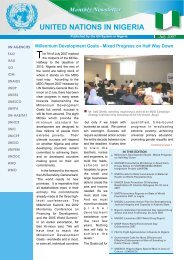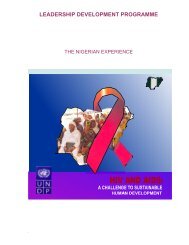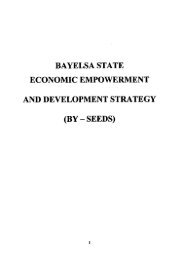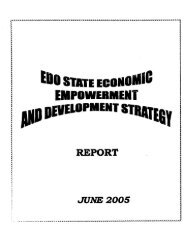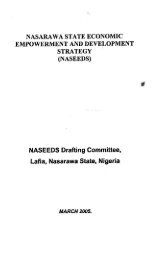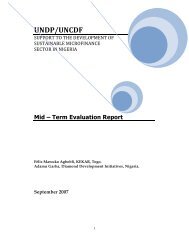Niger Delta Human Development Report - UNDP Nigeria - United ...
Niger Delta Human Development Report - UNDP Nigeria - United ...
Niger Delta Human Development Report - UNDP Nigeria - United ...
You also want an ePaper? Increase the reach of your titles
YUMPU automatically turns print PDFs into web optimized ePapers that Google loves.
1.4 Interpolation for Missing Data<br />
The data acquisition strategy for this report involved strenuous efforts to obtain figures<br />
from state and local government offices to fill gaps. All state capitals and local government<br />
headquarters were visited during the study. When there was no data even for the selected<br />
surrogates, standard interpolation techniques made it possible to obtain robust estimates<br />
for the missing data, with little bias and an appreciable level of accuracy.<br />
There are numerous standard interpolation techniques. Some, such as the moving average<br />
models, provide estimates by averaging the scores of selected neighbours. This method<br />
requires an objective way of selecting the appropriate number of neighbours, however.<br />
Other techniques, such as the trend surface model, use all the data points available. With<br />
this method, the problem of the number of neighbours does not arise. This report uses a<br />
combination of methods.<br />
TECHNICAL NOTE 2: CALCULATING THE HUMAN DEVELOPMENT<br />
INDICES (ADAPTED FROM <strong>UNDP</strong> 2003)<br />
2.1 The <strong>Human</strong> <strong>Development</strong> Index (HDI)<br />
The HDI is a summary measure of human development. Within the context of this<br />
report, it measures the average achievements in the <strong>Niger</strong> <strong>Delta</strong> region, its constituent nine<br />
states and 185 local government areas in three basic dimensions of human development:<br />
i. A long and healthy life, as measured by life expectancy at birth<br />
ii. Knowledge, as measured by the adult literacy rate (with two-thirds weight)<br />
and the combined primary, secondary and tertiary gross enrolment ratio (with<br />
one-third weight)<br />
iii. A decent standard of living, as measured by GDP per capital (PPPUS$)<br />
Before the HDI itself is calculated, an index needs to be created for each of these<br />
dimensions. To calculate these dimension indices—the life expectancy, education and GDP<br />
indices—minimum and maximum values (goal-posts) are chosen for each underlying<br />
indicator.<br />
Performance in each dimension is expressed as a value between 0 and 1 by applying the<br />
following general formula.<br />
Dimension index = actual value – maximum value<br />
maximum value – minimum value<br />
The HDI is then calculated as a simple average of the dimension indices.<br />
Goalposts for calculating the HDI: This report maintains the goalposts computed for the<br />
global <strong>Human</strong> <strong>Development</strong> <strong>Report</strong> in order to compare the results with other parts of<br />
the world where oil is major natural resource base. Given the level of resources generated<br />
from the region, it should rank as one of the best areas in the world in the three dimensions<br />
of human advancement.<br />
Maximum Minimum<br />
Indicator Value Value<br />
Life expectancy at birth (years) 85 25<br />
Adult literacy rate (%) 100 0<br />
Combined gross enrolment ratio (%) 100 0<br />
GDP per capita (PPP US$) 40,000 100<br />
NIGER DELTA HUMAN DEVELOPMENT REPORT<br />
215



